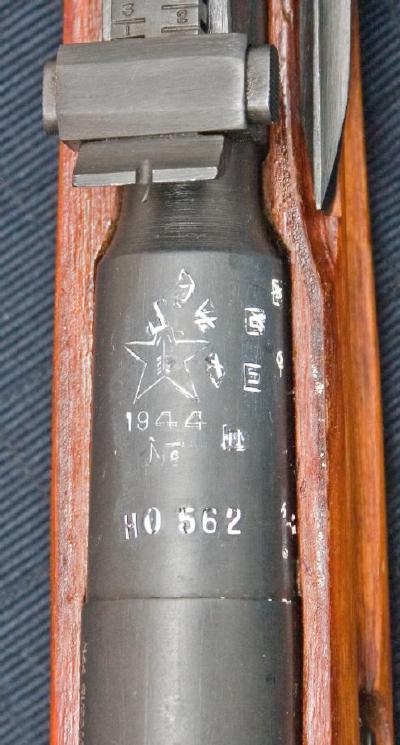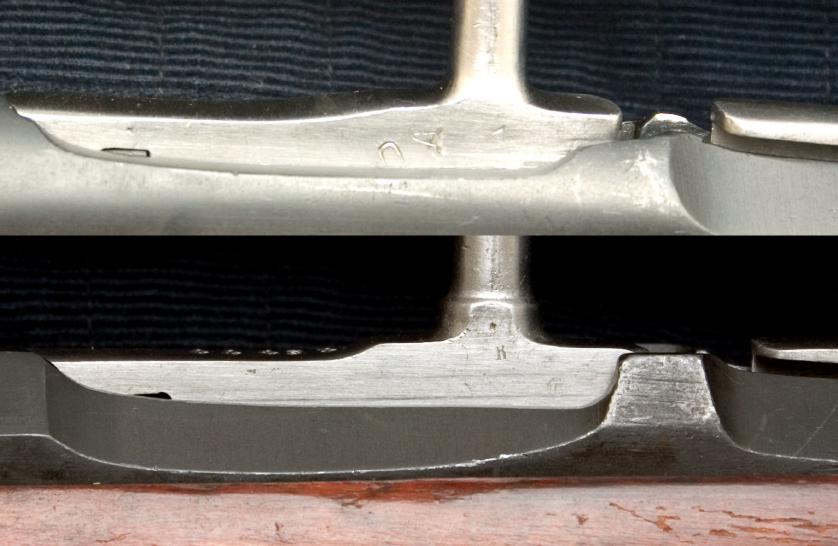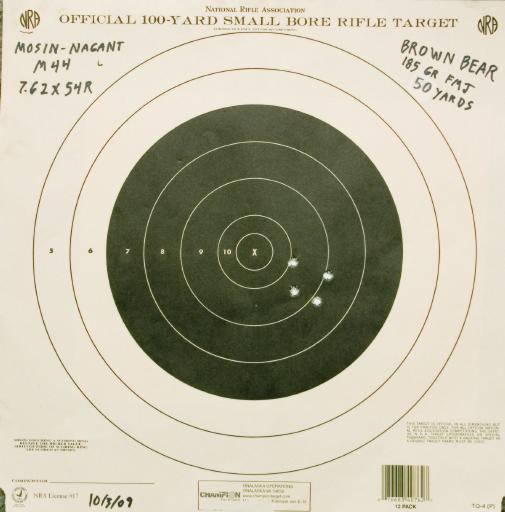Mosin-Nagant M44
(7.62x54R)
Gun collecting can be a pretty addictive hobby, and an
expensive one. Fortunately, there is one class of collectibles
that are within the reach of the average working man: the
Mosin-Nagant. Since there were litterally tens of millions of
these rifles made, with recent increases in imports
prices are pretty low, often less than $100 for the most
common variant, the 91/30. Still, except for the rarest of the
rare, prices generally stay below $350. If you can afford that
$1,200 shotgun, you can afford these.
For that reason, and the fact that the Mosin-Nagants have a
pretty cool history, I've been adding random samples to my
collection over time. Budget and time contraints led me to
pretty well curtail my collecting activities for a while but
some habits are hard to break. In the last few months, I had
set my mind on adding a M44 to my collection but decided to
hold off for a while to allow me time (and cash, don't forget
the cash) to take care of another (expensive) project I had
been working on.
Then came labor day. During that weekend, the hip thing for
most retailers is to have some sort of sale. Sporting goods
dealers are no exception to this. My local Big 5 opened a few
months ago but I never bothered to stop into it since compared
to the others dealers around here, "Big" isn't
exactly the right word. Nevertheless, the following weekend I
made the mistake of stopping in and browsing. I wasn't
expecting any collectibles, just the usual assortment of
long guns. Well, there in the corner at the end of the display
was a nice looking model 1944 Mosin-Nagant rifle. Whats more, their
sale wasn't over yet. This put that rifle at $50 under what I
had seen to be the going rate around town.
So here I am finding room to store another rifle in my
safe. Well, buying it now means one less I have to buy later
so it all balances out, right? Right?
The Model 1944
| Type: |
Bolt Action Rifle |
| Caliber: |
7.62x54R |
| Capacity: |
5 |
| Barrel Length: |
19 1/2 in. |
| Twist: |
1:9.5 |
| Overall Length: |
40 1/4 in. |
| Weight: |
apx 8.9 lb. |
| Sights: |
Post and Globe Front, Tangent Rear |
| Finish: |
Blue |
| Market Price: |
$150-$200 |
The Mosin-Nagant rifle had been in use for decades at the
start of WWII and had seen use in several conflicts beginning
with the Russo-Japanese war. During
that interval, a number of different configurations had been
tested. The most recent major change was in 1938. Original
model 1891 rifles were over 50 inches long without the
bayonet. These were shortened slightly over time but even the
1930 version had only lost a couple of inches. This was fine on the
open field but if you had to work inside a city or worse
inside a building, that rifle was hard to bring to bear. So in
1938 it got a haircut and ten inches disappeared from the
barrel.

During this era, the Tula ordnance facility used the mark of
an arrow insde a star. This should not be confused with the
arrow inside a triangle which was used at Izhevsk. (Note that
one set of inspection marks has been struck through.)
The 1938 rifle also got a new rear sight and an updated
stock. These modifications were carried over into the M1944
along with the addition of a permenantly attached folding
bayonet. The only key difference between a 1938 stock and a
1944 stock is the inletting on the right side of the stock for
the bayonet to rest in when folded. In all but a few minor
aspects, the stocks are otherwise identical.
As noted, this rifle is classed as a M1944, often just written
as M44. However there is some doubt in my mind about
this. You see, disassembling and inspecting this rifle shows
that while the rifle is configured as a 1944, the receiver is
from 1942. It is entirely possible that these was simply a
leftover but given the rate at which these rifles were being
produced, that is somewhat doubtful.
The other factor is that everything on the rifle is stamped
from the Izhevsk arsenal except for the bolt body, which has had
its serial number ground off—which also obliterated the
arsenal mark—and electro penciled with the new number,
and the barrel. In the case of the bolt, the rest of it is
properly stamped from Izhevsk so this was simply a mating of
different parts during an arsenal overhaul.
On the other hand, the barrel, is stamped not from Izhevsk but
from Tula. With the barrel stamped 1944 and the receiver 1942,
it seems more likely to me that this rifle is not an M44 but
actually a M38 that has been updated to the M44
configuration. This supposition is supported by the fact that
the barrel has two sets of inspection stamps on it, one being
crossed out in favor of the others.
It must be understood though that many M44 rifles were built
on reworked receivers and stocks from earlier rifles. I have
also been advised that the 1944 M44 was only made at Tula.
There are also additional marks on the receiver and receiver
tang that I do not believe are original to this
part. This too suggests a rework. When the barrel and
receiver were mated, it looks very much like they were
blued together since the coloring one to the other is
absolutely consistant. So this is not merely a rifle that has
been rebarreled. With the serial numbers being placed on the
various pieces by hand all at the same time (the style of
numbering is very consistant), that also lends
credence to a rework. So it may well be that this rifle is
every bit a Tula M44. Some of the experts in the circles I
haunt lend their oppinion to this interpretation.
Regardless of when the
parts were matched, beit during original assembly or during
refubishment, the rifle is currently in 1944 configuration,
and appears to have been made that way at the arsenal, bearing
inspection and proof marks that seem to have been placed there
as part of that operation.
Notable Features
During wartime production, the Soviets, under pressure from
both the Germans and the Finns, sought means to speed
production of rifles in any way they could. The most efficient
method was to examine the manufacturing operations and
function of the rifle and eliminate unnecessary
operations. Among these was a complete polish of the barrel
after it was machined. Only the barrel shank and muzzle have
been finely machined and polished on this rifle. The remainder
bears pronounced machining marks but this causes absolutely no
detriment to either fit or the durability of the finish.

This war time production receiver (top) has a "high
wall" configuration. Compare this with one from
an earlier era (bottom) and the difference is obvious.
Another method of reducing production complexity which appears
on this rifle was to simplify some of the operations on the
receiver. This receiver is what is termed a "high
wall" receiver because of the configuration of the left
side. You can see the difference in the accompanying
photo. Along with this, the area on the interior of the
receiver, behind the barrel threads,
rather than being tapered was cut clean through. Sometimes
this was done as part of a rebarreling operation rather than
as part of the initial manufacturing process.
Perhaps the quickest way to identify a M44 is by the fact that
it contains a permenantly attached, folding bayonet. The basic
design of the bayonet did not change, still being a cruciform
style blade, but it was shortened. The M44 only extends 12
inches past the muzzle as compared with 17 for the earlier
91/30. This, too, made work in close quarters somewhat easier
on the average soldier.
Staying On Target
Since this rifle was assembled so late in the war, it is not
likely that it saw much use. That has left the bore in quite
good shape. Early fall is typically a very busy time of year
for me these days so it was a couple of weeks after I picked
this rifle up before I was able to get it down to my local
rifle range for a bit of field testing. Thus far, every
Mosin-Nagant I have picked up has shot high. This rifle was no
exception with rounds floating about twelve inches high at 100
yards. After settling in and making the necessary adjustments,
I was able to print patterns measuring six inches. I'll admit,
though, that since I had appointments that afternoon I wasn't
taking quite the time I should have. I'm confident that
if I had been more careful, I could have gotten that pattern
tighter. This is evidenced by the fact that when I was checking
the drift at the start of my session, I was able to put four
rounds into just over an inch at 50 yards.

This war time rifle easily matches its competitors on the battlefield.
One thing about a shorter rifle is that felt recoil is most
deffinitely greater. The weight of the bayonet helps take care
of some of this but the missing mass of that extra ten inches
of barrel gets noticed pretty quickly. An interesting side
effect of the folding bayonet though is that the harmonics of
the barrel change when the bayonet is deployed. That means
your point of impact will also change. I was curious to see
just what the effects of this would be so I set up a large
target out at the 50 yard line and fired five rounds with the
bayonet folded and five rounds with it deployed, always aiming
at the bulls eye.
The results of this test were pretty interesting.
The rounds fired with the bayonet extended were just
about straight on while those with the bayonet folded
floated five inches off to the left. What that means is that as
a soldier, you have to be aware of what your rifle will do
when you fire it. In close, it makes little difference since
the round will still cause a lethal wound. But if you've got a
target a good distance off and aren't making the required
correction, you'll probably miss and if you can't see the
round impact, you may not even be aware of what's happening. I
suspect many of the troops were not concious of this little
oddity unless they were experienced marksmen.
Final Thoughts
The evolution of the Mosin-Nagant rifle is a pretty
interesting story. The Russian M44 is not quite the final
incarnation but was the last one Russia itself made. There
would be subtle changes before production ceased but the rifle
I have is pretty typical of what will be found. M44s are not
quite as common as the 91/30s but can be found at pretty well
any gun show.
It may not be the sleekest rifle out there but
it was not built to be pretty, it was designed to do a
job; a practical rifle for a practical need. Production
figures for the Mosin-Nagant are pretty
staggering and can at best only be estimated. Because of the
lack of records, we have absolutely no idea how many of these
rifles China made or how many might be in storage in that
country. We do know that Chinese M44s were made starting in
1953 and production continued until at least 1961 before being
completely replaced by the SKS and, later, the Kalashnikov
rifle.
Mosin-Nagant rifles have been used all over Europe and Asia
and have even made the odd appearance on the Arabian
peninsula. There were several Vietnam war trophies brought
back and some have documentation to prove that they were
battlefield captures. Even today, the Mosin-Nagant can still
be seen on occassion in Afghanistan. With surplus rifles still
abounding, it will be interesting to see just how long they
continue to be found on the world's battlefields.
|



